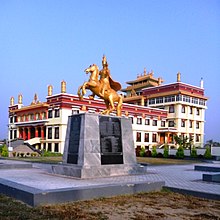
Back Diàspora tibetana Catalan Tibetská diaspora Czech Tibeta diasporo Esperanto Diáspora tibetana Spanish پراکنش تبتیها Persian Diaspora tibétaine French Tibetaanse diaspora Dutch Diáspora tibetana Portuguese Тибетская диаспора Russian 海外藏人 Chinese
| Languages | |
|---|---|
| Tibetan | |
| Religion | |
| Predominantly: Tibetan Buddhism Minority: Christianity |

The Tibetan diaspora is the relocation of Tibetan people from Tibet, their country of origin, to other nation states to live as exiles and refugees in communities. The diaspora of Tibetan people began in the early 1950s, peaked after the 1959 Tibetan uprising, and continues.
Tibetan emigration has four separate stages. The first stage occurred when Tibetans began escaping from Kham in the early and mid 1950's, and moving to India. The internal migration of masses of Tibetans from Amdo and Kham to Lhasa and central Tibet also occurred at this time, before the 1959 Tibetan uprising in Lhasa. The second stage followed the March 1959 escape by the 14th Dalai Lama from Lhasa to Himachal Pradesh, India, before he eventually settled in Dharamsala. The third stage occurred in the 1980s, when China's Central Government partially eased their brutality within Tibet, and opened Tibet to foreigners. The fourth stage began in 1996 after the kidnapping of the 11th Panchen Lama and the reopening of China's forced "Political Re-education" programs, and it continues today.
There is reported considerable social tension between second and third wave refugees, referred to as 'Shichak Tibetans' and fourth wave refugees referred to as 'Sanjor Tibetans'. The label 'Sanjor' is deemed a pejorative by the newcomer Tibetans.[1]
Not all emigration from Tibet is permanent; some parents in Tibet sent their children to the communities in the diaspora to receive a traditional Tibetan Buddhist education. The 2009 census registered about 128,000 Tibetans in exile, with the most numerous part of the community living in India, Nepal and Bhutan.[2] However, in 2005 and 2009 there were estimates of up to 150,000 living in exile.
- ^ "Sanjor vs Shichak .:. Tibet Sun". Archived from the original on 2020-08-09. Retrieved 2020-05-08.
- ^ "127935 Tibetans living outside Tibet: Tibetan survey". Press Trust of India. 2010-04-12. Archived from the original on 2011-09-27. Retrieved 2010-12-17.